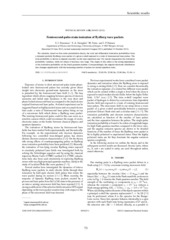| dc.contributor.author | Simonsen, Sigrid Ina | eng |
| dc.contributor.author | Sørngård, Stian Astad | eng |
| dc.contributor.author | Førre, Morten | eng |
| dc.contributor.author | Hansen, Jan Petter | eng |
| dc.date.accessioned | 2013-10-29T12:50:06Z | |
| dc.date.available | 2013-10-29T12:50:06Z | |
| dc.date.issued | 2012-10-09 | eng |
| dc.Published | Physical Review A 86: 043423 | eng |
| dc.identifier.issn | 1050-2947 | en_US |
| dc.identifier.uri | https://hdl.handle.net/1956/7449 | |
| dc.description.abstract | We calculate, based on first-order perturbation theory, the total and differential ionization probabilities from a dynamic periodic Rydberg wave packet of a given n-shell exposed to a train of femtosecond laser pulses. The total probability is shown to depend crucially on the laser repetition rate: For certain frequencies the ionization probability vanishes, while for others it becomes very large. The origin of this effect is the strong dependence of the ionization probability on the Stark quantum number. Correspondingly, the angular electronic distribution also changes significantly with the increasing number of pulses for certain repetition rates. | en_US |
| dc.language.iso | eng | eng |
| dc.publisher | American Physical Society | en_US |
| dc.relation.ispartof | <a href="http://hdl.handle.net/1956/7053" target="blank">The ionization dynamics of atoms and molecules exposed to short pulses</a> | en_US |
| dc.relation.ispartof | <a href="http://hdl.handle.net/1956/7662" target="blank">Dynamics of excited atoms and molecules interacting with external fields</a> | en_US |
| dc.title | Femtosecond-pulse-train ionization of Rydberg wave packets | en_US |
| dc.type | Peer reviewed | |
| dc.type | Journal article | |
| dc.description.version | publishedVersion | en_US |
| dc.rights.holder | Copyright 2012 American Physical Society. | en_US |
| dc.identifier.doi | https://doi.org/10.1103/physreva.86.043423 | |
| dc.identifier.cristin | 978222 | |
